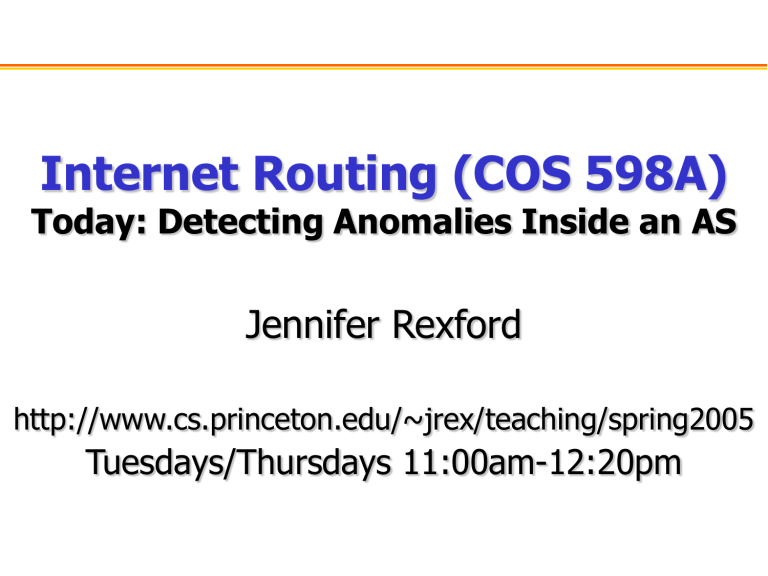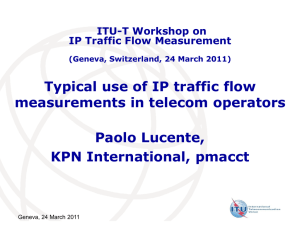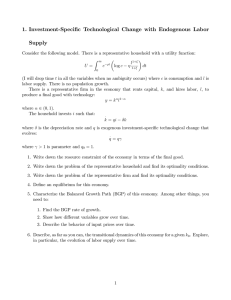Internet Routing (COS 598A) Jennifer Rexford Today: Detecting Anomalies Inside an AS

Internet Routing (COS 598A)
Today: Detecting Anomalies Inside an AS
Jennifer Rexford
http://www.cs.princeton.edu/~jrex/teaching/spring2005
Tuesdays/Thursdays 11:00am-12:20pm
Outline
• Traffic
– SNMP link statistics
– Packet and flow monitoring
• Network topology
– IP routers and links
– Fault data, layer-2 topology, and configuration
– Intradomain route monitoring
• Interdomain routes
– BGP route monitoring
– Analysis of BGP update data
• Conclusions
Why is Traffic Measurement Important?
• Billing the customer
– Measure usage on links to/from customers
– Applying billing model to generate a bill
• Traffic engineering and capacity planning
– Measure the traffic matrix (i.e., offered load)
– Tune routing protocol or add new capacity
• Denial-of-service attack detection
– Identify anomalies in the traffic
– Configure routers to block the offending traffic
• Analyze application-level issues
– Evaluate benefits of deploying a Web caching proxy
– Quantify fraction of traffic that is P2P file sharing
Collecting Traffic Data: SNMP
• Simple Network Management Protocol
– Standard Management Information Base (MIB)
– Protocol for querying the MIBs
• Advantage: ubiquitous
– Supported on all networking equipment
– Multiple products for polling and analyzing data
• Disadvantages: dumb
– Coarse granularity of the measurement data
• E.g., number of byte/packet per interface per 5 minutes
– Cannot express complex queries on the data
– Unreliable delivery of the data using UDP
Collecting Traffic Data: Packet Monitoring
• Packet monitoring
– Passively collecting IP packets on a link
– Recording IP, TCP/UDP, or application-layer traces
• Advantages: details
– Fine-grain timing information
• E.g., can analyze the burstiness of the traffic
– Fine-grain packet contents
• Addresses, port numbers, TCP flags, URLs, etc.
• Disadvantages: overhead
– Hard to keep up with high-speed links
– Often requires a separate monitoring device
Collecting Traffic Data: Flow Statistics
• Flow monitoring (e.g., Cisco Netflow)
– Statistics about groups of related packets (e.g., same IP/TCP headers and close in time)
– Recording header information, counts, and time
• Advantages: detail with less overhead
– Almost as good as packet monitoring, except no fine-grain timing information or packet contents
– Often implemented directly on the interface card
• Disadvantages: trade-off detail and overhead
– Less detail than packet monitoring
– Less ubiquitous than SNMP statistics
Using the Traffic Data in Network Operations
• SNMP byte/packet counts: everywhere
– Tracking link utilizations and detecting anomalies
– Generating bills for traffic on customer links
– Inference of the offered load (i.e., traffic matrix)
• Packet monitoring: selected locations
– Analyzing the small time-scale behavior of traffic
– Troubleshooting specific problems on demand
• Flow monitoring: selective, e.g,. network edge
– Tracking the application mix
– Direct computation of the traffic matrix
– Input to denial-of-service attack detection
Network Topology
IP Topology
• Topology information
– Routers
– Links, and their capacities
• Internal links inside the AS
• Edge links connecting to neighboring domains
• Ways to learn the topology
– Inventory database
– SNMP polling/traps
– Traceroute
– Route monitoring
– Router configuration data
Below IP
• Layer-2 paths
– ATM virtual circuits
– Frame Relay virtual circuits
• Mapping to lower layers
– Specific fibers
– Shared optical amplifiers
– Shared conduits
– Physical length (propagation delay)
• Information not visible to IP
– Stored in an inventory database
– Not necessarily generated/updated automatically
Intradomain Monitoring: OSPF Protocol
• Link-state protocol
– Routers flood Link State Advertisements (LSAs)
– Routers compute shortest paths based on weights
– Routers identify next-hop to reach other routers
3
2
4
1
1
2
5
3
3
1
Intradomain Route Monitoring
• Construct continuous view of topology
– Detect when equipment goes up or down
– Input to traffic-engineering and planning tools
• Detect routing anomalies
– Identify failures, LSA storms, and route flaps
– Verify that LSA load matches expectations
– Flag strange weight settings as misconfigurations
• Analyze convergence delay
– Monitor LSAs in multiple locations with go
– Compare the times when LSAs arrive
• Detect router implementation mistakes
Passive Collection of LSAs
• OSPF is a flooding protocol
– Every LSA sent on every participating link
– Very helpful for simplifying the monitor
• Can participate in the protocol
– Shared media (e.g., Ethernet)
• Join multicast group and listen to LSAs
– Point-to-point links
• Establish an adjacency with a router
• … or passively monitor packets on a link
– Tap a link and capture the OSPF packets
Reducing the Volume of Information
• Prioritizing the messages
– Router failure over router recovery
– Link failure or weight change over a refresh
– Informational messages about weight settings
• Grouping related messages
– Link failure: group messages for the two ends
– Router failure: group the affected links
– Common failure: group links failing close in time
Anomalies Found in the Shaikh04 paper
• Intermittent hardware problem
– Router periodically losing OSPF adjacencies
– Risk of network partition if 2 nd failure occurred
• External link flaps
– Congestion on edge link causing lost messages
– Lost adjacency leading to flapping routes
• Configuration errors
– Two routers assigned the same IP address
– Inefficient config leading to duplicate LSAs
• Vendor implementation bug
– More frequent refreshing of LSAs than specified
Interdomain Route Monitoring
Motivation for BGP Monitoring
• Visibility into external destinations
– What neighboring ASes are telling you
– How you are reaching external destinations
• Detecting anomalies
– Increases in number of destination prefixes
– Lost reachability to some destinations
– Route hijacking
– Instability of the routes
• Input to traffic-engineering tools
– Knowing the current routes in the network
• Workload for testing routers
– Realistic message traces to play back to routers
BGP Monitoring: A Wish List
• Ideally: knowing what the router knows
– All externally-learned routes
– Before policy has modified the attributes
– Before a single best route is picked
• How to achieve this
– Special monitoring session on routers that tells everything they have learned
– Packet monitoring on all links with BGP sessions
• If you can’t do that, you could always do…
– Periodic dumps of routing tables
– BGP session to learn best route from router
Using Routers to Monitor BGP
Talk to operational routers using SNMP or telnet at command line
(-) BGP table dumps are expensive
(+) Table dumps show all alternate routes
(-) Update dynamics lost
(-) restricted to interfaces provided by vendors
Establish a “passive” BGP session from a workstation running BGP software eBGP or iBGP
(+) BGP table dumps do not burden operational routers
(-) Receives only best routes from
BGP neighbor
(+) Update dynamics captured
(+) not restricted to interfaces provided by vendors
Seattle
Collect BGP Data From Many Routers
San
Francisco
Los Angeles
San Diego
Phoenix
Denver
Austin
Dallas
Kansas City
Cambridge
Chicago Detroit
New York
St. Louis
2
Philadelphia
Washington, D.C.
Atlanta
Orlando
Houston
BGP is not a flooding protocol
Route Monitor
Detecting Important Routing Changes
• Large volume of BGP updates messages
– Around 2 million/day, and very bursty
– Too much for an operator to manage
• Identify important anomalies
– Lost reachability
– Persistent flapping
– Large traffic shifts
• Not the same as root-cause analysis
– Identify changes and their effects
– Focus on mitigation, rather than diagnosis
– Diagnose causes if they occur in/near the AS
Challenge #1: Excess Update Messages
• A single routing change
– Leads to multiple update messages
– Affects routing decision at multiple routers
BGP
Updates
BGP Update
Grouping
Events
Persistent
Flapping
Prefixes
Group updates for a prefix with inter-arrival < 70 seconds, and flag prefixes with changes lasting > 10 minutes.
Determine “Event Timeout”
Cumulative distribution of BGP update inter-arrival time
(70, 98%) BGP beacon
Event Duration: Persistent Flapping
Complementary cumulative distribution of event duration
(600, 0.1%)
Long
Events
Detecting Persistent Flapping
• Significant persistent flapping
– 15.2% of all BGP update messages
– … though a small number of destination prefixes
– Surprising, especially since flap dampening is used
• Types of persistent flapping
– Conservative flap-damping parameters (78.6%)
– Protocol oscillations, e.g., MED oscillation (18.3%)
– Unstable interface or BGP session (3.0%)
Example: Unstable eBGP Session
AT&T
Peer p
Customer
• Flap damping parameters is session-based
• Damping not implemented for iBGP sessions
Challenge #2: Identify Important Events
• Major concerns of network operators
– Changes in reachability
– Heavy load of routing messages on the routers
– Flow of the traffic through the network
Events
Event
Classification
“Typed”
Events
No Disruption
Loss/Gain of Reachability
Internal Disruption
Single External Disruption
Multiple External Disruption
Classify events by type of impact it has on the network
Event Category – “No Disruption” p
AS
1
E E
AS
2
No Traffic Shift
“No Disruption”: each of the border routers has no traffic shift
Event Category – “Internal Disruption” p
AS
1
E E
AS
2
“Internal Disruption”: all of the traffic shifts are internal traffic shift AT&T
Internal Traffic Shift
Event Type: “Single External Disruption” p
AS
1
E E
AS
2 external Traffic Shift
“Single External Disruption”: traffic at one exit point shifts to other exit points
Statistics on Event Classification
No Disruption
Internal Disruption
Single External Disruption
Multiple External Disruption
Loss/Gain of Reachability
Events
50.3%
15.6%
20.7%
7.4%
6.0%
Updates
48.6%
3.4%
7.9%
18.2%
21.9%
Challenge #3: Multiple Destinations
• A single routing change
– Affects multiple destination prefixes
“Typed”
Events
Event
Correlation
Clusters
Group events of same type that occur close in time
Main Causes of Large Clusters
• External BGP session resets
– Failure/recovery of external BGP session
– E.g., session to another large tier-1 ISP
– Caused “single external disruption” events
– Validated by looking at syslog reports on routers
• Hot-potato routing changes
– Failure/recovery of an intradomain link
– E.g., leads to changes in IGP path costs
– Caused “internal disruption” events
– Validated by looking at OSPF measurements
Challenge #4: Popularity of Destinations
• Impact of event on traffic
– Depends on the popularity of the destinations
Clusters
Traffic Impact
Prediction
Netflow
Data
Large
Disruptions
Weight the group of destinations by the traffic volume
Traffic Impact Prediction
• Traffic weight
– Per-prefix measurements from Netflow
– 10% prefixes accounts for 90% of traffic
• Traffic weight of a cluster
– The sum of “traffic weight” of the prefixes
• Flag clusters with heavy traffic
– A few large clusters have large traffic weight
– Mostly session resets and hot-potato changes
Conclusions
• Network troubleshooting from the inside
– Traffic, topology, and routing data
– Easier to understand what’s going on
– … though still challenging to collect/analyze data
• Traffic measurement
– SNMP, packet monitoring, and flow monitoring
• Routing monitors
– Track network state and identify anomalies
– Intradomain monitor capturing LSAs
– BGP monitor capturing BGP updates
Next Time: BGP Routing Table Size
• Three papers
– “On characterizing BGP routing table growth”
– “An empirical study of router response to large
BGP routing table load”
– “A framework for interdomain route aggregation”
• Review only of the first paper
– Summary
– Why accept
– Why reject
– Avenues for future work
• Optional
– Vanevar Bush on “As We May Think” (1945)






